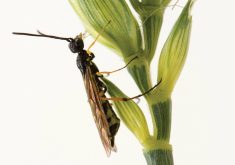Elgin ND promises high yields and better returns. Do those claims hold up in farmers’ fields? Two growers who tried out the new variety last year share their experience.
North Dakota State University plant breeders developed Elgin ND as a high-yielding milling variety. They first distributed it south of the border in 2013. In Canada, Elgin falls into the Canadian northern hard red class. FP Genetics is the Canadian retailer.
Jason Friesen grew about 800 acres of Elgin last year on his farm near Watson, Sask. He says most of the questions he gets from other farmers are about price differences, where the market is, and whether he felt it was worth growing.
Read Also

Conagra considers selling its share in Ardent Mills
Conagra is open to selling its 44 per cent share in Ardent Mills, North America’s largest milling company.
“We got a positive return on it for sure,” he says.
Haydon Rice of Asquith, Sask, says the biggest questions in his mind revolved around the new wheat class, elevator and mill acceptance. He says there’s still market development needed with mills, but elevator acceptance was good.
“I only see it going up from here,” says Rice.
Rice has several companies bidding on his Elgin. “The price is at a bit of a discount to the standard hard red spring wheat varieties. But I can see the yield is definitely out-weighing the discount on the price.”
Friesen had to shop around a little for the best deal for his farm’s Elgin. There were definitely places that would take it, but at a significant discount compared to a hard red, he says. But the high protein levels allowed him to sell directly to a flour mill at a decent price.
Both Rice and Friesen were happy with protein levels. Rice figures the Elgin sits at 14 to 14.5 per cent protein, which is average to good for his land. He didn’t have other hard reds to compare it to last year. Friesen says the protein levels in Elgin were consistently higher than other hard reds.
The biggest benefit compared to other hard reds was the yield, Friesen says. The Elgin yielded significantly more than other hard reds on the Friesen farm.
Rice grew soft white spring wheat last year, and he expected it to out-yield the Elgin. But he says “the Elgin ended up yielding more and being worth more. So I was happy on that end of things.”
Fighting fusarium
Fusarium head blight has become a chronic problem on many farms. Elgin has an Intermediate resistance rating for fusarium head blight, similar to Faller, Prosper, or AC Barrie.
“We definitely have a problem with fusarium head blight,” says Friesen. “I think (Elgin) handled it as well or better than our other wheat did. We spray everything. We’ve had to for quite a few years now. But even with spraying there was some fusarium damage in some of the other wheat.”
Rice also applies fungicide to all his wheat. He says the Elgin held up much better than the soft white last year.
Rice and Friesen treated the Elgin like other wheats when it came to fertility. Rice has had other varieties go down with his fertility program. But he had no lodging issues with Elgin ND.
Both Friesen and Rice found Elgin easier to harvest than some other hard reds. Rice says with some hard reds he’s had to set the concaves as tight as possible and the rotors as fast as possible. He’d use awning plates and blanking plates, and still have white caps, he says.
Elgin ND, Rice says, was “pretty easy to set and go, and it all thrashed out pretty easy.”
Like many farmers last year, Rice was harvesting late in the fall. His Elgin wheat was still standing after the October snow, and he ended up swathing and combining it in mid-November. The quality, he says, is “so-so.” He can’t say for sure whether that’s a varietal issue or “the terrible weather it sat through in the field.”
Still, Rice is happy with the variety overall. “It’s a good variety and I would definitely grow it again.”
Friesen says they’re cutting back their wheat acres “big time” next year. “But we’re maintaining our Elgin wheat and we’re putting in less hard red.”
















